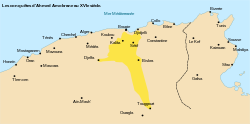
Back سلطنة بني عباس Arabic Labes Catalan Reino de Labes Spanish Royaume des Beni Abbès French Regno di Ait Abbas Italian Tagelda n At Ɛebbas KAB
Kingdom of Beni Abbas ⵜⴰⴳⴻⵍⴷⴰ ⵏ ⴰⵜ ⵄⴻⴱⴱⴰⵙ (Berber languages) Tagelda n Ait Abbas سلطنة بني عباس (Arabic) salṭanat Beni Ɛabbas | |||||||||
|---|---|---|---|---|---|---|---|---|---|
| 1510–1872 | |||||||||
|
Flag | |||||||||
 Kingdom of Ait Abbas at its greatest extent in the end of the 16th century. | |||||||||
| Capital | Kalâa of Ait Abbas | ||||||||
| Common languages | Berber, Arabic | ||||||||
| Religion | • Islam • Minorities: Christianity and Judaism | ||||||||
| Government | Monarchy | ||||||||
| Sultan | |||||||||
• 1510–1559 | Abdelaziz Labes | ||||||||
• 1871–1872 | Boumezrag El Mokrani | ||||||||
| Historical era | Early modern period | ||||||||
• Established | 1510 | ||||||||
• Disestablished | 1872 | ||||||||
| |||||||||
| Today part of | Algeria | ||||||||
| History of Algeria |
|---|
 |
The Kingdom of the Ait Abbas or Sultanate of the Beni Abbas (Berber languages: ⵜⴰⴳⴻⵍⴷⴰ ⵏ ⴰⵜ ⵄⴻⴱⴱⴰⵙ, romanized: tagelda n At Ɛebbas; Arabic: سلطنة بني عباس salṭanat Beni Ɛabbas) was a Kabyle,[1] Berber state of North Africa, then a fief and a principality, controlling Lesser Kabylie and its surroundings from the sixteenth century to the nineteenth century. It is referred to in the Spanish historiography as "reino de Labes";[2] sometimes more commonly referred to by its ruling family, the Mokrani, in Berber At Muqran (Arabic: أولاد مقران Ouled Moqrane). Its capital was the Kalâa of Ait Abbas, an impregnable citadel in the Biban mountain range.
The kingdom was for a long time a bastion of resistance to the Spanish Empire, then to the Regency of Algiers. Strategically located on the road from Algiers to Constantine and from the Mediterranean Sea to the Sahara, the Kalâa of Ait Abbas, attracted Andalusians, both Christians and Jews, in the sixteenth century, fleeing Spain or Algiers. Their know-how enriched a local industrial fabric whose legacy is the handicraft of the Ait Abbas tribe. The surrounding tribes were also home to intense intellectual activity and a literary tradition that rivalled those of other Maghreb cities.
At its peak, the influence of the kingdom of Ait Abbas extended from the valley of the Soummam to the Sahara and its capital the Kalâa rivalled the biggest cities. In the seventeenth century, its chiefs took the title of sheikh of the Medjana, but were still described as sultans or kings of the Beni Abbés.[2] At the end of the eighteenth century, the kingdom led by the Mokrani family (Amokrane) broke up into several clans, some of which became vassals of the Regency of Algiers. However, the Sheikh of the Medjana maintained himself at the head of his principality as a tributary of the bey of Constantine, managing his affairs independently.
With the arrival of the French, some Mokrani took the side of the colonisers, while others sided with the resistance. The French relied on local lords to strengthen their hold in the region, maintaining an appearance of autonomy in the region under its traditional leaders until 1871. Its sovereigns assumed various titles, successively sultan, amokrane[3] and sheikh of the Medjana. Temporarily integrated into the French military administration before the revolt of 1871, they were known as khalifa and bachagha. The defeat of 1871 marked the end of the political role of the Mokrani with the surrender of the Kalâa to the French.
- ^ "Le Royaume fort et indépendant des Ath Abbas (1510 -1871)".
- ^ a b Afrique barbaresque dans la littérature française aux XVIe et XVIIe siècles by Guy Turbet-Delof p.25
- ^ "Amokrane" means "chief" or "big" in kabyle.
© MMXXIII Rich X Search. We shall prevail. All rights reserved. Rich X Search

